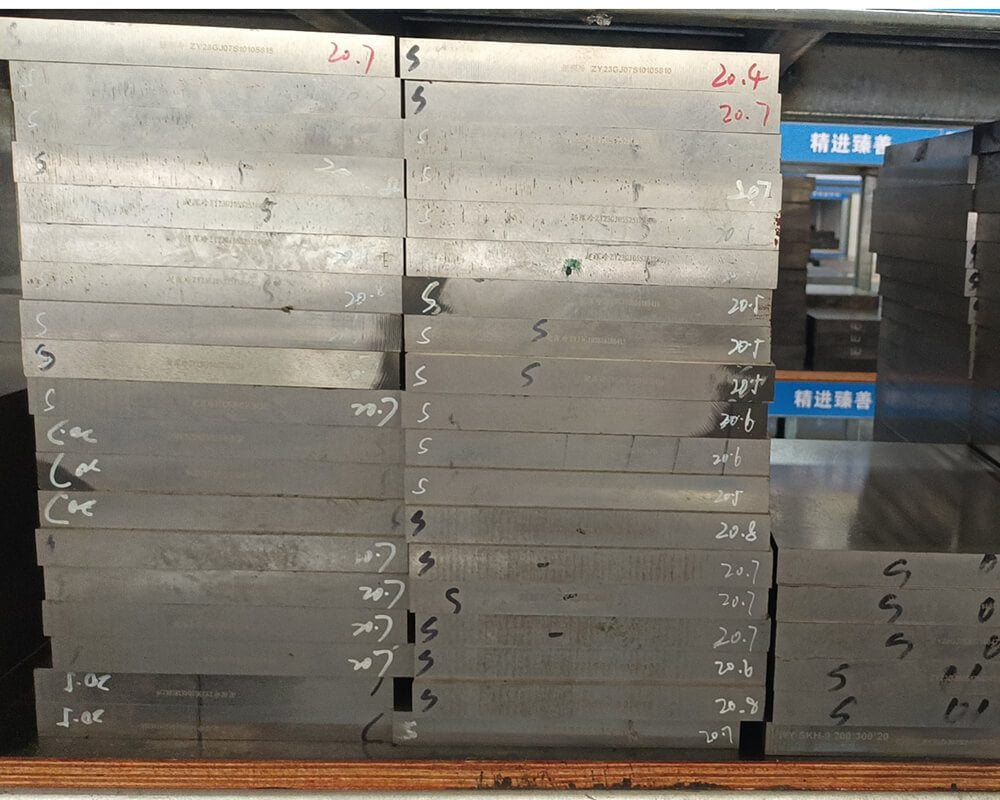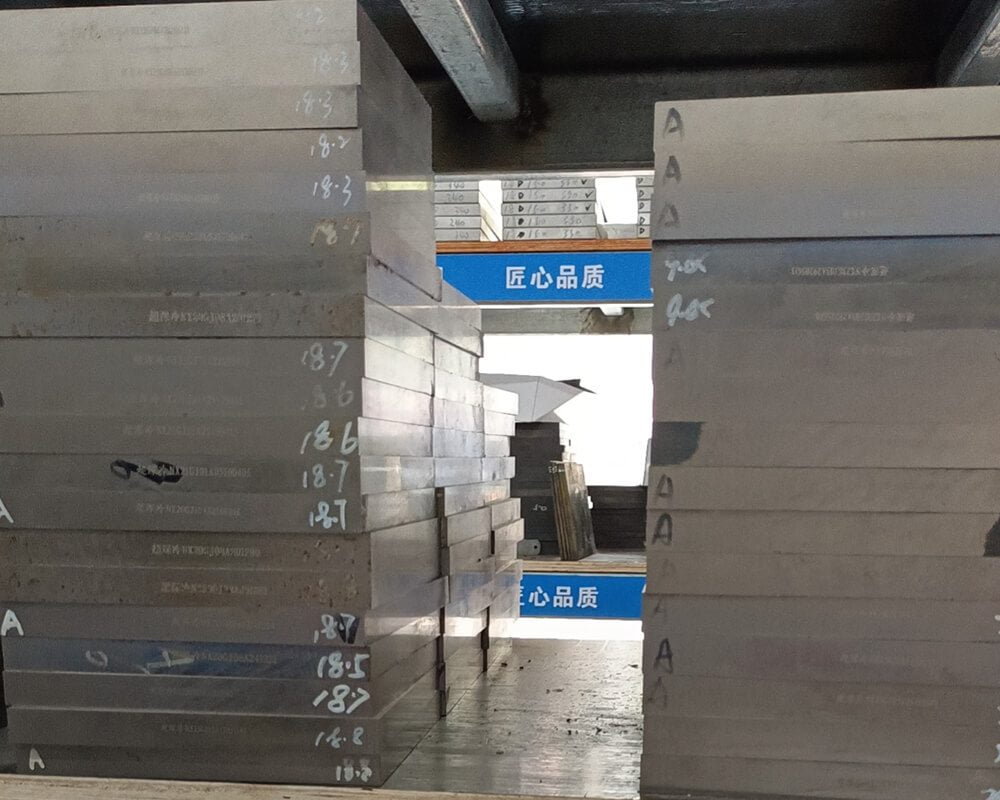HSS is known for its versatility, durability, and ability to maintain cutting performance even at high speeds and temperatures. The choice of HSS grade depends on the specific application, material to be machined, cutting speed, and other factors to ensure efficient and precise machining operations.

M2 High Speed Steel
High speed steel (HSS) tools are renowned for their ability to maintain their hardness, wear resistance, and cutting performance even at high speeds and temperatures. Here are some key characteristics and common uses of high-speed steel:
Characteristics:
High Hardness: HSS exhibits excellent hardness, making it suitable for cutting and machining applications.
High Wear Resistance: It offers superior wear resistance, ensuring a longer tool life and reduced downtime for tool changes.
Heat Resistance: HSS can withstand elevated temperatures generated during high-speed machining without losing its hardness or cutting ability.
Toughness: HSS maintains its toughness and impact resistance, reducing the risk of tool breakage during machining.
Good Red Hardness: Red hardness refers to the ability of a material to maintain its hardness at high temperatures. HSS exhibits good red hardness, allowing it to maintain its cutting edge even when subjected to extreme heat.
Machinability: HSS is known for its good machinability, allowing for the fabrication of complex tool geometries.
Application
Cutting Tools: High-speed steel is used for a wide range of cutting tools, including drills, end mills, taps, reamers, and saw blades. These tools are employed in metalworking, woodworking, and other machining operations.
Turning Tools: HSS turning tools are used in lathe operations to machine a variety of materials, including metals, plastics, and composites.
Milling Cutters: HSS milling cutters are used for milling and machining operations on both ferrous and non-ferrous materials.
Drill Bits: HSS drill bits are commonly used in drilling holes in metal, wood, plastic, and other materials.
Saw Blades: HSS saw blades are used for cutting metal, plastic, and wood in various industries.
Reamers: HSS reamers are used to create precise and smooth holes in metal parts.
Taps and Dies: HSS taps and dies are essential tools for threading operations in manufacturing.
Broaches: HSS broaches are used to create keyways, splines, and other intricate shapes in machined parts.
Gears and Gear Cutting Tools: HSS is employed in the production of gears and gear-cutting tools for various industries.
Aerospace and Automotive Components: HSS tools are used in the manufacturing of critical components in the aerospace and automotive industries, where precision and durability are essential.
Automotive Components: HSS is used for machining automotive parts, including engine components, transmission components, and chassis components.
Woodworking Tools: In woodworking, HSS tools such as planer knives, jointer knives, and router bits are used to shape and finish wood products.
Tool and Die Making: HSS is used in the fabrication of dies, punches, and tooling for various manufacturing processes, including stamping, forging, and extrusion.
Metal Forming and Cold Heading: HSS is used for cutting and forming tools in metal forming processes like cold heading, where precise shapes are created from metal wire.
Extrusion Dies: HSS is employed in the manufacture of extrusion dies for producing various profiles and shapes from metal, plastic, and rubber materials.

WE OFFER
| Steel Type | GERMANY | AISI | Sweden | JAPAN | FUSHUN | Grade | Hardness HB or HRC | Ultrasonic TEST | Hot rolled plate sizes range | Hot forged plate and block sizes range | Round bar sizes range |
| High Speed Steel | 1.3343 | HS6-5-2C | — | — | — | M2 | 61-64KRC | Sep1921-84 E/e | Machined Dia 20-200mm |
High Hardness: HSS exhibits excellent hardness, making it suitable for cutting and machining applications.
High Wear Resistance: It offers superior wear resistance, ensuring a longer tool life and reduced downtime for tool changes.
Heat Resistance: HSS can withstand elevated temperatures generated during high-speed machining without losing its hardness or cutting ability.
Toughness: HSS maintains its toughness and impact resistance, reducing the risk of tool breakage during machining.
Good Red Hardness: Red hardness refers to the ability of a material to maintain its hardness at high temperatures. HSS exhibits good red hardness, allowing it to maintain its cutting edge even when subjected to extreme heat.
Machinability: HSS is known for its good machinability, allowing for the fabrication of complex tool geometries.
Common Applications:
Cutting Tools: High-speed steel is used for a wide range of cutting tools, including drills, end mills, taps, reamers, and saw blades. These tools are employed in metalworking, woodworking, and other machining operations.
Turning Tools: HSS turning tools are used in lathe operations to machine a variety of materials, including metals, plastics, and composites.
Milling Cutters: HSS milling cutters are used for milling and machining operations on both ferrous and non-ferrous materials.
Drill Bits: HSS drill bits are commonly used in drilling holes in metal, wood, plastic, and other materials.
Saw Blades: HSS saw blades are used for cutting metal, plastic, and wood in various industries.
Reamers: HSS reamers are used to create precise and smooth holes in metal parts.
Taps and Dies: HSS taps and dies are essential tools for threading operations in manufacturing.
Broaches: HSS broaches are used to create keyways, splines, and other intricate shapes in machined parts.
Gears and Gear Cutting Tools: HSS is employed in the production of gears and gear-cutting tools for various industries.
Aerospace and Automotive Components: HSS tools are used in the manufacturing of critical components in the aerospace and automotive industries, where precision and durability are essential.
Automotive Components: HSS is used for machining automotive parts, including engine components, transmission components, and chassis components.
Woodworking Tools: In woodworking, HSS tools such as planer knives, jointer knives, and router bits are used to shape and finish wood products.
Tool and Die Making: HSS is used in the fabrication of dies, punches, and tooling for various manufacturing processes, including stamping, forging, and extrusion.
Metal Forming and Cold Heading: HSS is used for cutting and forming tools in metal forming processes like cold heading, where precise shapes are created from metal wire.
Extrusion Dies: HSS is employed in the manufacture of extrusion dies for producing various profiles and shapes from metal, plastic, and rubber materials.
The choice of HSS grade depends on the specific application, material being machined, cutting speed, and other factors. HSS tools are widely used in industries such as metalworking, aerospace, automotive, woodworking, and manufacturing, where high cutting speeds, precision, and tool longevity are essential for efficient production.
High-speed steel (HSS) is typically classified and designated using various standards, and its naming convention may not always follow the AISI (American Iron and Steel Institute) system. However, there are some common AISI designations for specific types of high-speed steel. Here are a few examples:
AISI M1 (T11301): AISI M1 is a tungsten-molybdenum high-speed steel known for its excellent red hardness and wear resistance. It is used for cutting tools, such as drills and milling cutters.
AISI M2 (T11302): AISI M2 is a tungsten-molybdenum high-speed steel and one of the most widely used grades in the M-series. It offers high hardness, wear resistance, and excellent heat resistance. M2 is commonly used for drills, taps, reamers, and other cutting tools.
AISI M35 (T11335): AISI M35 is a cobalt-containing high-speed steel with improved heat resistance compared to M2. It is often used for cutting tools that need to operate at higher temperatures, such as broaches and gear hobs.
AISI M42 (T11342): AISI M42 is another cobalt-containing high-speed steel known for its exceptional red hardness and wear resistance. It is used for cutting tools, such as drills, end mills, and saw blades.
AISI T1 (T12001): AISI T1 is a tungsten high-speed steel known for its excellent heat resistance and toughness. It is often used for high-speed milling cutters and other cutting tools.
AISI T15 (T12015): AISI T15 is a tungsten high-speed steel with improved heat resistance and toughness compared to T1. It is used for cutting tools that need to withstand high temperatures, such as hot forming tools and extrusion dies.
Please note that these AISI designations are not an exhaustive list of all high-speed steel grades. HSS grades are designated based on their composition and specific properties, and there are other standards and naming conventions used in various regions and industries. The choice of HSS grade depends on the specific requirements of the cutting or machining application, including cutting speed, material being machined, and desired tool life. Manufacturers and engineers select the appropriate grade to ensure efficient and precise machining operations.
Various countries and regions use their own classification systems and designations for high-speed steel (HSS), which may differ from the AISI (American Iron and Steel Institute) system commonly used in North America. These classification systems are established by national or international standards organizations to categorize and specify HSS grades based on their composition and properties. Here are some examples of such systems used in different countries:
DIN (Deutsches Institut für Normung – German Institute for Standardization): Germany uses the DIN system to classify HSS. For example, “DIN S6-5-2” is equivalent to AISI M2.
JIS (Japanese Industrial Standards): Japan uses the JIS system to designate HSS grades with alphanumeric codes. For example, “JIS SKH2” is equivalent to AISI T1.
ISO (International Organization for Standardization): ISO has international standards for high-speed steels, including designations like “ISO 4957 HS6-5-2” and “ISO 4957 HS18-0-1,” which correspond to AISI M2 and AISI T1, respectively.
BS (British Standards): The British Standards Institution (BSI) uses its own system for categorizing HSS grades. For instance, “BS 4659 BM2” is equivalent to AISI M2.
EN (European Norm): In Europe, HSS grades are often designated using EN standards. For example, “EN ISO 4957 HS6-5-2C” corresponds to AISI M2.
GB (Guobiao – Chinese National Standards): China uses the GB standard system to classify HSS grades. For instance, “GB/T 9943 W6Mo5Cr4V2” is equivalent to AISI M2.
These are just a few examples of classification systems used in different countries and regions. Each system has its own naming convention and designations for HSS grades.
When working with HSS, it’s essential to refer to the relevant standards and specifications to understand the properties and characteristics of a particular grade, regardless of the naming convention used. This ensures that the appropriate HSS grade is selected for a specific cutting or machining application.
High-speed steel (HSS) is classified and designated differently in various systems, including the AISI (American Iron and Steel Institute) system used in North America and the DIN (Deutsches Institut für Normung – German Institute for Standardization) system used in Germany. Here are some common HSS grades along with their equivalents in both the AISI and DIN systems:
AISI and DIN HSS Grades:
AISI M2 (DIN 1.3343): AISI M2 is a tungsten-molybdenum high-speed steel known for its high hardness, excellent wear resistance, and good red hardness. It is commonly used for drills, milling cutters, and other cutting tools.
AISI M35 (DIN 1.3243): AISI M35 is a cobalt-containing high-speed steel with improved heat resistance compared to M2. It is often used for cutting tools that require high-temperature performance, such as broaches and gear hobs.
AISI M42 (DIN 1.3247): AISI M42 is another cobalt-containing high-speed steel known for its exceptional red hardness and wear resistance. It is used for cutting tools, including drills, end mills, and saw blades.
AISI T1 (DIN 1.3355): AISI T1 is a tungsten high-speed steel with excellent heat resistance and toughness. It is often used for high-speed milling cutters and other cutting tools.
AISI T15 (DIN 1.3202): AISI T15 is a tungsten high-speed steel with improved heat resistance and toughness compared to T1. It is used for cutting tools that need to withstand high temperatures, such as hot forming tools and extrusion dies.
These grades are widely recognized and used in the industry, and they offer varying levels of performance in terms of hardness, wear resistance, heat resistance, and toughness.
The choice of HSS grade depends on the specific cutting or machining application, including factors such as cutting speed, material to be machined, and desired tool life.
Ask for quote